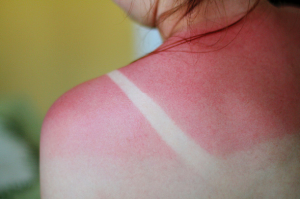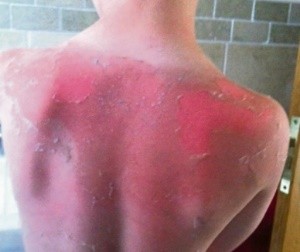Summer is in full swing and there are a few safety precautions we need to think about when we hit the beaches, creeks and lakes. We need to prepare our delicate skin to take the abuse of the elements outside such as the direct sunlight as well as wind and water that can be harsh to our skin. Protecting our skin is just one of the things we can do. Getting a great sunscreen to help protect ourselves against sunburn and these sunscreens can be store bought or homemade. Web MD has a great break down of what you really need when protecting yourself against UVA and UVB rays. Here is what they say about finding the best sunscreens. “Sunscreens help shield you from the sun's dangerous ultraviolet (UV) rays in two ways. Some work by scattering the light, reflecting it away from your body. Others absorb the UV rays before they reach your skin. Research soon showed that ultraviolet A rays (UVA) also increase skin cancer risk. While UVA rays don't cause sunburn, they penetrate deeply into skin and cause wrinkles. The Environmental Protection Agency estimates that up to 90% of skin changes associated with aging are really caused by a lifetime's exposure to UVA rays. The New Broad-Spectrum Sunscreens SPF 15 or higher for UVB protection. The SPF factor rates how effective the sunscreen is in preventing sunburn caused by UVB rays. If you'd normally burn in 10 minutes, SPF 15 multiplies that by a factor of 15, meaning you could go 150 minutes before burning.” You can read the full article here. (http://www.webmd.com/beauty/sun/whats-best-sunscreen).

If you were to be outside and receive a first degree sunburn, you may find it irritating, uncomfortable and warm to the touch. The first aid administration would to be: get out of the elements, cool the burned area thoroughly. For the minor superficial sunburn there are after sun products such as aloe that can be placed on the burn to help comfort the person.

If the burn happens to damage some of the underlying tissue, you want to do the same steps for first degree burns, only this time you will probably have small tiny blisters on the surface of the skin. It is important not to manually (take a pin and pop them) bust these blisters. The blister creates a protective coating that protects the underlying flesh and once new skin is being formed, the skin will naturally bust and begin to peel after a couple of days. It is important not to force the peeling skin, often times it is itchy and people will scratch the area and try to peel the dead skin off, this could be still attached to skin that is not quite ready to come off and it will create a small wound that could bleed. Keep the area moist with after sun care products made specifically for sun burns and reapply. Keeping the area and the individual hydrated will help the recovery process. The recovery time for a second degree sunburn is a little lengthier and a little more uncomfortable due to the skin loss. Long term effects of the sun could lead to an increased risk of skin cancer so always take precautions when exposed to the sun for extended periods of time. If you have been exposed to the elements for an extended period of time over several years, you may find yourself with sunspots or moles on your skin. If the spots/moles begin to change, it is advisable to go see a dermatologist just to make sure it does not turn into skin cancers. Remember, pack some sunscreen in your first aid kit when you hit the outdoors.

Barbara Jackson worked through college as a non-traditional student earning her Master of Science degree in health science focusing in health education. Barbara then went on to set for her national credential exam in 2011 earning her CHES (Certified Health Education Specialist) credential as well as being a Licensed Training Provider. Barbara has found her calling as a teacher and began working as a volunteer with the American Red Cross and became a CPR instructor for the Red Cross in 2007, since this time she has earned her teaching credential for American Heart Association and National Safety Council. Barbara is also an adjunct instructor for Arkansas Tech University teaching Responding to Emergencies: Comprehensive First Aid/CPR courses.
More articles by the writer
Summer is in full swing and there are a few safety precautions we need to think about when we hit the beaches, creeks and lakes. We need to prepare our delicate skin to take the abuse of the elements outside such as the direct sunlight as well as wind and water that can be harsh to our skin. Protecting our skin is just one of the things we can do. Getting a great sunscreen to help protect ourselves against sunburn and these sunscreens can be store bought or homemade. Web MD has a great break down of what you really need when protecting yourself against UVA and UVB rays. Here is what they say about finding the best sunscreens. “Sunscreens help shield you from the sun's dangerous ultraviolet (UV) rays in two ways. Some work by scattering the light, reflecting it away from your body. Others absorb the UV rays before they reach your skin. Research soon showed that ultraviolet A rays (UVA) also increase skin cancer risk. While UVA rays don't cause sunburn, they penetrate deeply into skin and cause wrinkles. The Environmental Protection Agency estimates that up to 90% of skin changes associated with aging are really caused by a lifetime's exposure to UVA rays. The New Broad-Spectrum Sunscreens SPF 15 or higher for UVB protection. The SPF factor rates how effective the sunscreen is in preventing sunburn caused by UVB rays. If you'd normally burn in 10 minutes, SPF 15 multiplies that by a factor of 15, meaning you could go 150 minutes before burning.” You can read the full article here. (http://www.webmd.com/beauty/sun/whats-best-sunscreen).

If you were to be outside and receive a first degree sunburn, you may find it irritating, uncomfortable and warm to the touch. The first aid administration would to be: get out of the elements, cool the burned area thoroughly. For the minor superficial sunburn there are after sun products such as aloe that can be placed on the burn to help comfort the person.

If the burn happens to damage some of the underlying tissue, you want to do the same steps for first degree burns, only this time you will probably have small tiny blisters on the surface of the skin. It is important not to manually (take a pin and pop them) bust these blisters. The blister creates a protective coating that protects the underlying flesh and once new skin is being formed, the skin will naturally bust and begin to peel after a couple of days. It is important not to force the peeling skin, often times it is itchy and people will scratch the area and try to peel the dead skin off, this could be still attached to skin that is not quite ready to come off and it will create a small wound that could bleed. Keep the area moist with after sun care products made specifically for sun burns and reapply. Keeping the area and the individual hydrated will help the recovery process. The recovery time for a second degree sunburn is a little lengthier and a little more uncomfortable due to the skin loss. Long term effects of the sun could lead to an increased risk of skin cancer so always take precautions when exposed to the sun for extended periods of time. If you have been exposed to the elements for an extended period of time over several years, you may find yourself with sunspots or moles on your skin. If the spots/moles begin to change, it is advisable to go see a dermatologist just to make sure it does not turn into skin cancers. Remember, pack some sunscreen in your first aid kit when you hit the outdoors.
Vlad Magdalin